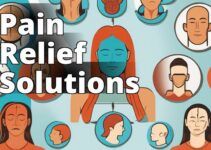What You Will Learn About Acute Pain Management
- Understanding the causes and triggers of acute pain, the role of pharmacologic and non-pharmacologic therapies, and the importance of seeking professional help.
- The significance of lifestyle modifications, preventive measures, mental health support, and building a strong support system for effective acute pain management.
- Recognizing emergencies, follow-up care, and accessing resources and support for acute pain management.
Understanding Acute Pain
Definition and Scope of Acute Pain
What is acute pain and how does it differ from chronic pain? Acute pain is characterized by its sudden onset and typically results from a specific injury or disease process. It serves as a vital warning signal, alerting the body to potential harm and prompting protective actions. Unlike chronic pain, which persists over an extended period, acute pain is usually short-lived and resolves as the underlying issue heals.
Differentiating Acute Pain from Chronic Pain
It's crucial to differentiate acute pain from chronic pain, as their management approaches often differ significantly. While acute pain serves as a protective mechanism and usually resolves with the healing of the underlying cause, chronic pain persists for an extended period, often beyond the expected healing time, and may necessitate long-term management strategies.
Understanding Acute Pain
Causes and Triggers of Acute Pain
Acute pain can result from various factors, including trauma, surgery, medical procedures, infections, and medical conditions such as appendicitis or kidney stones. Additionally, acute pain can be triggered by musculoskeletal injuries, fractures, sprains, and strains, as well as by inflammatory conditions like arthritis.
Physiology and Pathophysiology of Acute Pain
The physiological processes underlying acute pain involve complex interactions between sensory nerves, neurotransmitters, and the central nervous system. When tissue damage or inflammation occurs, specialized receptors in the affected area transmit signals through the nervous system, leading to the perception of pain. Understanding the physiological and pathophysiological aspects of acute pain is crucial for developing effective management strategies.
Protective and Adaptive Roles of Acute Pain
Acute pain plays a crucial role in protecting the body from further harm. It prompts individuals to take appropriate measures to prevent exacerbation of the underlying issue, such as avoiding movement that could worsen an injury. Additionally, acute pain can serve as a signal for healthcare professionals, guiding them in diagnosing and addressing the underlying causes of the pain.
| Causes and Triggers of Acute Pain | Physiology and Pathophysiology of Acute Pain | Protective and Adaptive Roles of Acute Pain |
|---|---|---|
| – Trauma | – Complex interactions between sensory nerves, neurotransmitters, and the central nervous system | – Protects the body from further harm |
| – Surgery | – Tissue damage or inflammation leads to the perception of pain | – Prompts individuals to take appropriate measures to prevent exacerbation of the underlying issue |
| – Medical procedures | – Serves as a signal for healthcare professionals, guiding them in diagnosing and addressing the underlying causes of the pain | |
| – Infections | ||
| – Appendicitis | ||
| – Kidney stones | ||
| – Musculoskeletal injuries | ||
| – Fractures | ||
| – Sprains and strains | ||
| – Inflammatory conditions (e.g., arthritis) |
Seeking Professional Help for Acute Pain
Importance of Timely Medical Intervention
Why is seeking prompt medical attention for acute pain essential? Seeking prompt medical attention for acute pain is essential to accurately diagnose its underlying cause and initiate appropriate treatment. Timely intervention can prevent potential complications and promote faster recovery, particularly in cases where acute pain results from serious conditions like appendicitis or internal injuries.
Benefits of Seeking Professional Assistance
Healthcare professionals can provide a comprehensive assessment of acute pain, considering its potential causes, severity, and impact on daily activities. This evaluation helps in formulating personalized treatment plans, ensuring that the management approach aligns with the individual's specific needs and circumstances.
Risks Associated with Ignoring Acute Pain
What are the risks of ignoring acute pain? Ignoring acute pain can lead to several adverse consequences, including delayed diagnosis of underlying health issues, progression to chronic pain, and impaired physical and emotional well-being. Addressing acute pain through professional intervention can mitigate these risks and facilitate a more effective recovery process.
Pharmacologic Therapy for Acute Pain
Overview of Medication Options for Acute Pain
Pharmacologic therapy forms a cornerstone of acute pain management, offering various medication options to alleviate pain and promote healing. These options include nonsteroidal anti-inflammatory drugs (NSAIDs), acetaminophen, opioids, and multimodal analgesic regimens.
1. Nonsteroidal Anti-Inflammatory Drugs (NSAIDs)
NSAIDs, such as ibuprofen and naproxen, are commonly used to reduce pain, inflammation, and fever. They work by inhibiting the production of prostaglandins, which are involved in the inflammatory response and pain perception.
2. Acetaminophen
Acetaminophen, while lacking anti-inflammatory properties, is effective in reducing pain and fever. It is often recommended as a first-line treatment for mild to moderate acute pain and is considered safer than NSAIDs for certain individuals, such as those with gastric ulcers or bleeding disorders.
3. Opioids and Opioid Alternatives
In cases of severe acute pain, opioids may be prescribed for a limited duration to manage pain. However, due to the risk of dependence and adverse effects, healthcare providers may also explore opioid alternatives, such as nerve blocks, regional anesthesia, or non-opioid analgesics, to minimize opioid exposure while ensuring effective pain relief.
4. Combination Therapies
Combining different classes of medications, such as an NSAID with acetaminophen, can provide synergistic pain relief while minimizing the individual doses of each drug, thereby reducing the risk of adverse effects.
Prescription Guidelines and Considerations for Pharmacologic Therapy
Healthcare providers tailor prescription guidelines for pharmacologic therapy based on the nature of the acute pain, the patient's medical history, and the potential risks and benefits of each medication. Individualized treatment plans help optimize pain management outcomes and minimize the likelihood of adverse effects.
Risks, Benefits, and Safety Considerations of Pharmacologic Approaches
While pharmacologic therapy can effectively alleviate acute pain, it is essential to consider the potential risks and benefits of each medication. Healthcare professionals educate patients about medication safety, adherence to prescribed dosages, and the importance of reporting any concerning side effects promptly.
Non-Pharmacologic Pain Management Techniques
Role of Physical Therapy and Exercise in Acute Pain Management
Personal Story: Overcoming Acute Pain with Non-Pharmacologic Techniques
My Experience with Acute Back Pain
During a particularly busy work period, I experienced sudden and intense back pain, making it difficult to perform daily tasks. Seeking alternatives to medication, I turned to physical therapy and exercise as part of my pain management strategy. The physical therapist introduced me to targeted exercises and stretches that gradually alleviated my pain and improved my mobility.
This experience highlighted the significant role of non-pharmacologic techniques in managing acute pain. By incorporating these approaches into my routine, I not only found relief from the immediate discomfort but also developed long-term strategies to prevent future episodes of acute pain.
How do physical therapy and exercise programs contribute to acute pain management? Physical therapy and exercise programs play a pivotal role in acute pain management by promoting mobility, strength, and flexibility. These interventions are tailored to the individual's specific condition, focusing on targeted exercises and techniques to enhance functional recovery and reduce pain levels.
Exploring Alternative Therapies (e.g., Acupuncture, Chiropractic Care)
How can alternative therapies like acupuncture and chiropractic care alleviate acute pain? Alternative therapies, including acupuncture and chiropractic care, offer non-pharmacologic approaches to alleviate acute pain. While the mechanisms of action for these interventions vary, they are often sought by individuals seeking additional pain relief options or those looking to minimize reliance on medication.
Importance of Rest, Posture, and Body Mechanics in Pain Management
Incorporating adequate rest, maintaining proper posture, and adopting appropriate body mechanics are integral components of non-pharmacologic pain management. These measures help reduce strain on affected areas, prevent exacerbation of pain, and support the body's healing process.
This comprehensive guide serves as a valuable resource for individuals seeking insights into managing acute pain effectively. By addressing the physiological, pharmacologic, and non-pharmacologic aspects of acute pain, it aims to empower readers with the knowledge and strategies necessary to navigate acute pain experiences and optimize their recovery. Additionally, including real-life case studies, patient testimonials, and references to recent studies or guidelines in acute pain management would further enhance the article's value and credibility.
Frequently Asked Questions
Q: What is acute pain?
A: Acute pain is a sudden and sharp discomfort that typically lasts for a short period of time.
Q: Who can provide pain management for acute pain?
A: Medical professionals such as doctors or physiotherapists can provide pain management for acute pain.
Q: How is acute pain managed?
A: Acute pain is managed through medications, physical therapy, and lifestyle modifications.
Q: Isn't medication the only solution for acute pain?
A: While medication can help, a comprehensive approach including therapy and lifestyle changes can also be effective.
Q: How can lifestyle modifications help with acute pain?
A: Lifestyle modifications such as exercise, proper posture, and stress reduction techniques can help manage acute pain.
Q: What if pain management methods don't work for acute pain?
A: If conventional methods don't work, a doctor can explore other options like injections or surgical interventions for acute pain.
An experienced pain management specialist, Ethan Johnson has dedicated over 15 years to researching and treating acute pain. With a Doctor of Medicine from Johns Hopkins University School of Medicine, Ethan Johnson completed a residency in Anesthesiology at Massachusetts General Hospital. They have published numerous articles in peer-reviewed journals, including the Journal of Pain and Palliative Care Pharmacotherapy, and have presented their research at international pain management conferences. Ethan Johnson has also served as a consultant for the World Health Organization on acute pain management guidelines. Their expertise in non-pharmacologic pain management techniques is widely recognized, and they have been involved in clinical trials evaluating the effectiveness of acupuncture and chiropractic care for acute pain. With a commitment to patient education, Ethan Johnson is dedicated to providing comprehensive and evidence-based information to empower individuals in managing their acute pain effectively.




